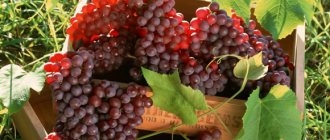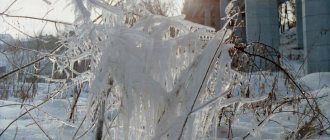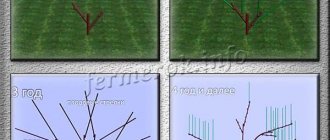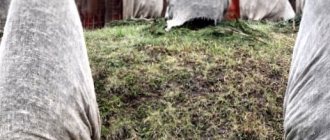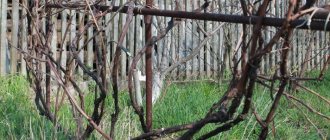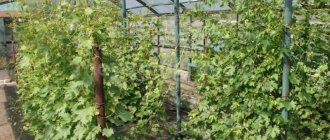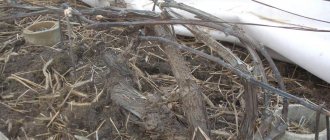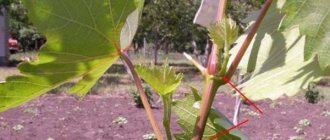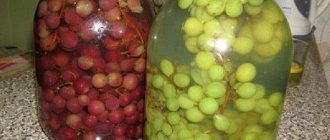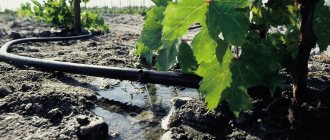The timing of covering grapes for the winter depends on the region where the vineyard is located.
Victor Tatievsky
We all learned from the books of southern authors, but, gradually gaining experience and developing our own technology for northern viticulture, we began to understand that this experience was not suitable for us. It is also better for winegrowers in central Russia to work using our technologies, rather than those from the south. Our technologies are developed “with reserve”: if the winter is harsh, then the measures taken will save the grapes, and if it’s mild, then it’s okay if somewhere we overdo it with protection from frost.
Vitor Tatievsky in his vineyard.
After long discussions of many years of experience, northern winegrowers came to the conclusion that it is better to cover the grapes before frost.
Dubrovsky pink
Victor Tatievsky
It all depends on the technology that the winegrower uses. If it puts a lot of stress on the bush, then the vine ripens early, so you can cover it early - I know a winegrower who covered his bushes until September 15th. I don’t do this myself, but I have to do it before frost. From October 15 to October 20, you can safely close. If you do this later, the vine must be protected from frost, covered with polycarbonate, covering material, or polyethylene.
Shelter methods and climatic nuances
Most covering methods come down to three solutions - complete covering of the vine, semi-covering and hilling. The choice depends on the varietal preferences of the summer resident and the climatic characteristics of the region. Hilling is recommended for gardeners living in mild climates (southern regions).
The head of a fruiting (adult or young) bush is covered with a layer of soil. The lower part of the shoots and the commissure must also be protected. The method is labor-intensive because you need to pour a 25-centimeter mound. As a result, the root system will be completely protected.
Expert opinion: “The disadvantage of this method lies in the insecurity of the kidneys. If severe frosts hit, the plant may die.”
Half cover
The lower part of the grape crown is very susceptible to cold, so it can be protected by the semi-covering method. The bases of the shoots, the head of the bush and the sleeves are protected with earth, and other parts with covering materials. This kind of “drape” serves as additional protection.
What materials are called covering materials? Summer residents use all kinds of fabrics, agrofibre, straw and spruce branches. The material must be tied together with twine to form a “protective suit” (its thickness will be about 4 centimeters). For combined grape varieties, semi-shelter is ideal.
Full Cover
This technology involves the complete removal of vines from the trellises followed by defoliation. The bush bends down to the soil and is protected with natural fabrics (you can use old blankets or worn out clothes). A layer of film insulation is placed on top. Important: the film should not come into contact with the buds, otherwise the vine will freeze and “burn” with the arrival of spring.
During severe night frosts, you can light fires near the vineyard
The fabric structure is pressed to the ground and fixed using arc brackets. The thickness of the soil layer with which the vines are sprinkled is about 10-30 centimeters. The harsher the winter, the thicker the layer. Please note the following points:
- Soil (full) cover gives 100% protection to your plants.
- Frost-resistant crops can be insulated with slate and roofing felt.
- If the winter is warm, ventilation must be provided.
- During severe frosts at night, you can light fires near the vineyard.
Why should the vine be protected from frost?
The vine may not be ripe in the fall, and encountering frost will be disastrous for it. In addition, the first frosts can be quite severe, and they can kill the buds of even mature vines.
Electrical tape marks the border between ripened and unripe vines; this will allow you to see which part of the vine will ripen under cover in winter.
Victor Tatievsky
Much depends on the frost resistance of the variety, but the bush gains frost resistance gradually. If the frost resistance of a bush is -30 degrees or more, then in September it is -5 - -6 degrees, in October -7 and below, and so on. Therefore, frosts in the first ten days of October are especially dangerous. And if the variety is not winter-hardy, frost resistance indicators are lower, then the first frost can kill the vine.
Winegrowers usually make shelter for all the bushes at once, without dividing them into frost-resistant and non-frost-resistant. Therefore, it is better to play it safe and cover everything early.
A vine that has not been hit by frost is always preserved better during wintering.
Spruce spruce branches and reed mats
The vines are removed from the trellises, undergo a pruning procedure and are laid on coniferous spruce branches. The shoots prepared in this way are tied and attached to the soil with wire. A layer of spruce branches is placed on top, the thickness of which is approximately 5-10 centimeters. The next layer is board panels, then roofing felt is laid (can be replaced with polyethylene).
Some summer residents successfully replace spruce branches with mats woven from sun-dried reeds. The width and length depend on the area of the vineyard, but the thickness should be at least 7 centimeters. Procedure:
- Tie the vines of the nearest pair of shrubs together.
- Secure the bundles with arcs (distance from the soil - 10-15 cm).
- Place boards along the edges of the structure.
- Place mats and plastic wrap on top.
Proper design includes vents. Ventilation can be regulated by sealing the vents in frost and opening them during thaw. If you follow our instructions, the grapes will not rot in the spring and will withstand the severe winter cold.
How to cover grapes for the winter
This is how Viktor Tatievsky himself does it
- Spreads polyethylene on the ground.
Victor Tatievsky
Polyethylene becomes a barrier between the vine and parasitic fungi and microorganisms in the soil, which lead to the formation of mold and damping off. While studying the physiology of grapes, I found several more ways to create such a barrier: pouring an even layer of sand, laying roofing felt... Any wrapping of the vine (in a covering material, in a polypropylene bag) will also create such a barrier.
But, according to Viktor Vasilyevich, polyethylene in the design of a winter shelter has an important advantage - it significantly reduces the humidity of the vine. The photos below show the opening of grapes in the spring of 2017. We see that the huge puddles in the shelter did not damage the vine in any way; it is dry and clean.
- Places the vines on polyethylene, tying them into bundles with ropes if necessary. If wrapping is planned, then tying into bundles is necessary.
- Covers the vine from above with covering material and insulation.
Victor Tatievsky
If the winegrower expects that the winter will be cold, frosts will come early, and there will be little snow at this time, it is better to use 4-6 layers of covering material. If other insulation is used: spruce branches, bags with foam chips, sawdust or leaves, then 1-2 layers of covering material will be sufficient.
Our expert has been using No. 60 agril bags with foam chips for several years. For reliability, the agrill is folded in two layers.
Bag dimensions: unfolded: length 2 m, width 0.7 m, thickness 0.1 m (150 liters of foam chips are poured into the bag).
The bag turns out to be very light, it is easy to give it the desired shape, it does not put pressure on the vine, does not cake and does not get wet. The chips can be purchased from a building supply store or from a foam board manufacturer.
- Another layer of covering material is placed on the bags so that they remain clean after wintering, and another layer of polyethylene is placed on top.
Victor Tatievsky
Polyethylene protects the vine from precipitation. And two layers of polyethylene, at the bottom of the shelter and on top, create the effect of a double-glazed window and retain heat well.
Damping off with this design of winter shelter for grapes is excluded.
Victor Tatievsky
All moisture comes from the soil, and if there is polyethylene below, there will be no damping off. But in the spring the top polyethylene will need to be removed.
This is an axiom: if the grapes are covered with an airtight material on top, it must be removed in early spring.
Victor Tatievsky
I remove the polyethylene in early spring and leave only two layers of covering material, adding polyethylene only when necessary.
Disadvantages of early and late covering of mature grape bushes
Timely covering of grapes will allow you to preserve even the weakest grape bushes and destroy healthy perennial grape plants if the timing of covering the plant for the winter period is not followed correctly. The main disadvantages of early and late covering of grapes are presented in the table:
| Disadvantages of early shelter | Disadvantages of late hiding |
| The vines of the vineyard do not have time to accumulate useful substances. Such a plant becomes too weak and not ready to overwinter. | The buds on the vines freeze. The vines of such a plant most likely will not bloom in the spring, and plant growth will begin from the root collar. |
| The grape vines first become fogged, then warm up in the shelter, which creates favorable soil for the development of fungal diseases. | The forced dormancy phase will lengthen; buds will begin to germinate only at the end of February, instead of the beginning of January. |
Tip #1. In the middle zone, grapes are ready for shelter at the end of October. Many winegrowers recommend focusing on weather conditions, which undergo changes annually and are unstable.
Is it necessary to spray the vine with vitriol?
Before wintering, grapes are sprayed with iron or copper sulfate to destroy pests that may overwinter on the vine.
Iron sulfate also slows down the growing season: in the south, this technique allows you to avoid spring frosts, but in northern viticulture it has a negative effect.
Copper sulfate does not slow down the growing season, but it is not a fact that there is much benefit from it. There was a big discussion in the Russian grape community about the need for its use, and the participants came to the conclusion that such spraying was most likely not necessary.
Victor Tatievsky
Honestly, I have never sprayed grapes with copper and iron sulfate, neither in spring nor in autumn. But I don’t do anything unless really necessary, “just in case.” Everything is fine with me without spraying, my vineyard is always clean.
But let us repeat - our expert grows grapes in the Altai region, where the crop is infected with diseases and pests much less than in the south and even in Central Russia.
Preparing for shelter
Having figured out when to cover the grapes in the fall, begin the preparatory work. First you need to do the annual autumn and formative pruning. The first is done on fruit-bearing vines, the second on young ones. After this, you can begin harvesting fallen leaves from the vineyard.
Before sheltering, you need to do formative pruning
After pruning, you will still have vines - they need to be removed from the trellises and carefully tied up. Winegrowers form fascines using wire or rope, or fasten the vines to the ground with staples. Bound branches are laid along the row, and the beds are treated with iron sulfate. The solution should be three or four percent.
Summarizing
As Viktor Tatievsky says, each winegrower develops his own technology, using the materials that are at hand. When you try and experiment, you will definitely find your own, the best way of winter shelter for grapes. But the general direction should remain this way:
- It is better to cover the grapes before frost sets in;
- It is necessary to create a barrier between the vine and microorganisms that live in the soil;
- Having laid the vine on the barrier, you need to pin it to the ground;
- The insulation layer must be sufficient;
- The top of the structure must be covered with polyethylene - this will protect it from precipitation and effectively retain heat.
We invite you to read an article on FORUMHOUSE about how to get a grape harvest a year earlier, as well as chat about grape topics, learn winemaking and watch a video in which Viktor Tatievsky talks in detail about the technologies of northern viticulture.
Subscribe to our Telegram channel Exclusive posts every week
Features of sheltering young grapes
A young, not yet mature plant is insulated until the temperature drops below zero. Young grapes are not fed in the fall and are not pruned.
They practice high hilling (to a height of 30-40 cm) of the seedling with dry soil or mulching with sawdust and fallen leaves. The uncovered vine is rolled into a ring and covered with a piece of agrofibre. The structure is covered with soil on top or covered with spruce branches.
Method for increasing winter hardiness of grapes
A young grape plant is covered when the night air temperature reaches -2..-3C.
Grape growers increase the winter hardiness of grapes through the hardening procedure and proper ripening of the grapes. Grape growers note that the hardening procedure is necessary for strong, healthy grape vines, since even such plant bushes are not able to withstand low temperatures while under cover.
The main stages of preparation during the growing season and ripening of grapes:
- During the growing season, pay special attention to the load on the grape bushes. If necessary, remove excess shoots and thin out the grape bushes in order to prevent them from being overloaded with the harvest. Bushes bearing a large amount of crops closer to the winter period become weakened with a minimum amount of nutrient reserves.
- At the initial stage of the growing season, it is necessary to fertilize with nitrogen fertilizers. In the middle and end of the growing season, fertilize the grapes with phosphorus and potassium.
Frost-resistant, uncovered grape varieties
Varieties of grapes classified as non-covered can be grown in areas where the minimum temperature exceeds -29-35 degrees or more. The berries have a denser skin, and the vine does not require care. For the winter it is left in the same place where it grew (including arches, arbors).
A common popular name for uncovered varieties is Isabella or American, because most species were bred in the USA (and Canada). But the achievements of Russian breeders are also included in this group.
Sharov's riddle
A grape bred in the 70s by a gardener from the Altai region, Rostislav Sharov, and adapted to harsh conditions. It ripens early, withstands cold temperatures of -35°C and stores well for a long time.
It has an average yield. The fruits are sweet, round, with a dense dark red skin. The clusters are large, 300-600 g depending on the region. The variety is very early, the fruits fully ripen by day 110, and in the greenhouse 1.5 weeks earlier.
Northern Saperavi
A variety with a medium ripening period (from 140 days), bred on the basis of an ancient Georgian variety. Technical. It is grown for fresh consumption, production of wines, juices and their coloring.
The berries are oval, dark blue in color, with thick skin and juicy pulp, with a simple taste. The variety is moderately resistant to drought, but tolerates harsh winters, although according to some agronomists in the northern regions it needs insulation.
Productivity from 115 c/ha, stable. Tolerates transportation well. Other advantages include resistance to mildew.
Valiant
A grape that can withstand very low temperatures (-45-46 degrees). Mid-early, growing season – from 130 days. Blue berries appear on the bushes, collected in medium-sized clusters weighing 100 g each.
The variety is characterized by medium sugar content and is rated very highly by gourmets. The variety is used for winemaking and making jelly. Among the disadvantages are the slow development of the vine in the first years, medium-sized fruits (1.5-2.5 g) and average resistance to fungal diseases.
Relines pink seedlis
An American variety developed in the 80s, it has all the advantages of good grapes: early ripening (ripens in 100-110 days), resistance to fungal diseases (does not require chemicals), increased winter hardiness, and absence of seeds.
Its unpretentiousness and vitality make it a desirable crop in temperate latitudes. The taste of Reliance Pink Seedlies is original, with a hint of strawberry. Fruitfulness is good, from one hectare you can get 120-150 centners of harvest. The disadvantage is that the berries are small, up to 2-3 g each.
Maurice Early
A versatile, highly resilient grape developed in North America - one version from Concord seed by Captain John Moore. Known as Early Moore, Moore's early.
The grapes have good yields and are used as an early table variety. Ripening time is the end of September. The clusters and berries are medium in size, the fruits are almost black in color, and have an “isabelle” taste.
Maurice Early is suitable for cultivation in uncovered crops in the Moscow region and other areas of temperate latitude, as well as to the north. Tolerates harsh winters with frosts of -35-36 degrees.
Winchell
A hybrid from America known as Green Mountain. Ripens early, has medium-sized bushes with small light berries. The inside of the fruit is loose, with a strawberry flavor and aroma.
Young shoots ripen well, survive frosts down to -30 and are immune to fungal diseases. Table variety, suitable for fresh consumption and decoration of areas (i.e. gazebo).
Lucille
A universal variety, suitable for creating landscapes, as well as making juices, jellies and jams. The clusters are oval and can reach a weight of 900 g. Lucille has a nutmeg taste; if there is little sun, the berries will sour.
The fruits are not very large, dark pink, purple, and ideal in shape. The variety can withstand frosts down to -30-33 degrees, recommended for cultivation in the Moscow region. Ideal for a small garden in a suburban area.
Productivity is above average, stable, starting from the third year - in the first year the vine gains strength.
Louise Swanson
The American originator E. Swenson developed this frost-resistant grape and named it after his wife Louise. It received variety status in 2001, and was then recognized as one of the best.
Stable harvest. On days 125-135 after the buds appear, the fruits are fully ripe. Dense and medium-sized clusters appear on the bushes. The berries are soft green, moderate acidity, average taste.
Used for wine production. The fruits can remain on the vine for a long time. The variety is not prone to diseases. Tolerates severe frosts down to -35°C, but may suffer from drought.
The danger of frost for grapes
Spring is not only the time for plants to awaken, but also a dangerous time for temperature changes. Thus, grapes, regardless of varietal frost resistance, love warmth and suffer from cold. Therefore, many gardeners prefer to play it safe and cover their plantings for the winter, digging them out only when the temperature is stable at 8-12 °C.
During the period of revival of the vine, temperatures even at -0 degrees can lead to freezing of the eyes. And this affects both the growth of the plant and the time of flowering and the amount of harvest. If the vine is damaged by frost, the sap channels have frozen and the plant no longer receives the required amount of nutrition from the soil.
Types of frost
It is also important what type of frost came to the vineyard growing area - advective or radiation. The most dangerous is advective cooling. It is very difficult to fight it, sometimes even impossible. Such frosts are characterized by a several-day drop in temperature.
More often, the crop can withstand radiation cooling, that is, if the vines are frozen at night, then during the day they must warm up. This type of frost occurs more often at night and is concentrated at the ground level where the vineyard grows. Such frosts can and should be fought.
FAQ
Question No. 1. We have several grape bushes growing on our site - some bushes are already bearing fruit abundantly, others are at the first-year stage. Is it possible to cover them for the winter at the same time?
This is possible only if more mature grape bushes are characterized as weakened, for example, after a rich harvest or after a disease. If adult bushes are strong and healthy, then young bushes can be covered with light spunbond material in several layers before the onset of stable frosts. When severe frosts occur, young plants are covered with other grape bushes.
Sheltering grape seedlings for the winter
Question No. 2. How to protect covered grapes from melt water?
Before covering, the grape bushes are covered with plastic film, and the top is covered with roofing felt, on top of which they are covered with sheets of slate. A layer of soil from 10 to 20 cm is laid between the roofing felt and slate.
Question No. 3. Is it necessary to monitor the layer of snow that covered the grapes?
Winegrowers recommend monitoring the level of snow cover throughout the winter period. In case of heavy snowfall, the layer is increased in advance to 50 cm.
Question No. 4. Why can’t you take soil under grape bushes?
When taking soil from under grape bushes, there is a risk of exposing the roots, which will lead to the death of the entire plant.
Question No. 5. Why do they leave air vents while covering the grapes?
Ventilators provide ventilation, which prevents the formation of excess moisture and condensation. Otherwise, there is a possibility of rotting of the roots, as well as overheating of the buds and shoots.
The main mistakes of novice winegrowers when covering grapes in the middle zone
Spunbond SUF 40 is considered a lightweight covering material for grape bushes.
- The timing of covering the vineyard was chosen incorrectly.
- They did not carry out the procedure for preparing the grape vines for their shelter for the winter.
- The method of covering the vineyard does not correspond to the region.
- They covered the vineyard without creating vents.
At what temperature should you cover grapes?
There are many winter-hardy grape hybrids that can withstand temperatures down to -25°C -28°C. But even their kidneys can suffer when the temperature drops to -20°C. In this case, the vine dies completely. And at even lower temperatures the eyes die completely. The same applies to annual vines and even perennials.
Many gardeners believe that 1 cm of snow holds 1°C. With a snow depth of 50 cm, the temperature at the ground surface remains close to 0°C. But in cold, snowless winters when the air temperature drops to -25 °C without shelter, the death of most grape buds is inevitable, up to the loss of the bush. And the winters now are such that there is a warming, during which almost all the snow melts away. And then it freezes.
When to remove insulation
They begin to remove the covering material in mid-April - early May, after the snow has melted. First of all, when the temperature reaches around 5ºC, remove the film protecting from moisture. Since night temperatures during this period are often negative, a temporary greenhouse should be built over the vine from arcs and covering material. You need to gradually accustom the vine to the sun, first removing the spunbond for several hours on cloudy days, and always covering it from frost at night. You can completely remove the shelter when the temperature is positive and no night frosts or recurrent cold are expected. For additional stimulation of the kidneys and warming up the root system, the grapes are shed 2-3 liters once. water heated to 30ºC.
The influence of temperature on the condition of the vineyard
The condition of the vineyard is significantly affected by weather instability in the autumn and spring periods and sudden temperature changes. They have a particularly detrimental effect on young bushes. In stable conditions, this crop can easily tolerate frosts down to -16ºС. With a further decrease in temperature in non-frost-resistant grape varieties, the buds on the vine begin to die, and after -20ºC all the buds die, regardless of the age of the bush.
The vine root is a much less frost-resistant part of the plant. Already at -6 ºС, its individual sections die off, the general nutrition of the bush is disrupted, and it dies. If the above-ground part of the plant is able to regenerate, then the root freezes completely.
There are two types of grape bush:
- frost-resistant;
- non-frost-resistant.
Depending on its hardiness, it is covered or not, but too severe frosts or sudden temperature changes require sheltering of resistant varieties. Moreover, this must be done in advance, anticipating weather changes.
